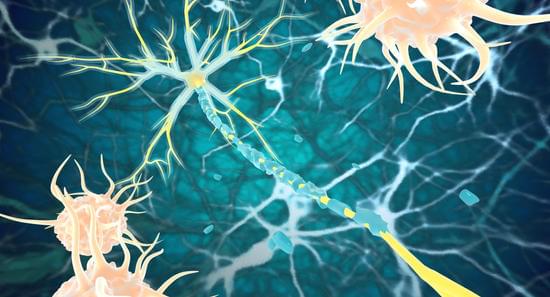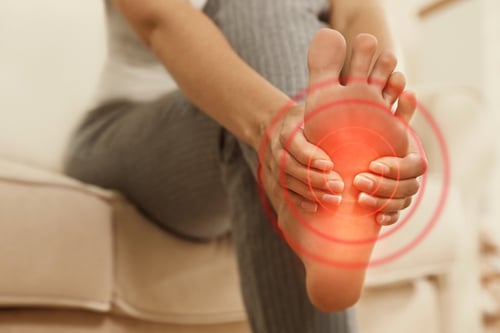Understanding Idiopathic Polyneuropathy: A Guide for Patients

Have you been experiencing numbness, tingling, or pain in your hands and feet? These symptoms can be unsettling, and you might be wondering what's causing them. One possibility is a condition called idiopathic polyneuropathy.
“Idiopathic sensory-motor polyneuropathy is an illness where sensory and motor nerves of the peripheral nervous system are affected, and no obvious underlying etiology is found. In many respects, the symptoms are very similar to diabetic polyneuropathy,” says Johns Hopkins Medicine Neurology and Neurosurgery.
In simpler terms, it's a condition that affects your nerves, but doctors haven't been able to pinpoint the exact reason why.
Idiopathic neuropathy, also known as chronic idiopathic axonal polyneuropathy (CIAP), is a major health problem in the United States, according to a paper published in the Journal of Peripheral Nervous System, with the disorder affecting an estimated 5 to 8 million Americans.
Let's break down idiopathic polyneuropathy and understand what it means for you.
What is Idiopathic Polyneuropathy?
Imagine your body as a complex network of highways. Nerves act as these highways, carrying messages back and forth between your brain and spinal cord to all other parts of your body.
These messages tell your muscles to move, your skin to feel sensations like hot and cold, and your organs to function properly.
Idiopathic polyneuropathy simply means "unknown nerve disease affecting many nerves."
“Sometimes peripheral neuropathy seems to happen for no particular reason. Doctors call this disorder “idiopathic,” which means that no etiology has been identified despite appropriate investigations,” says the Foundation for Peripheral Neuropathy. “Typically, idiopathic peripheral neuropathy occurs in people over 60 years old; progresses slowly (or doesn’t progress at all after the initial onset); and it can be very disruptive to someone’s normal life and lifestyle.”
Understanding Our Nerves
To understand idiopathic polyneuropathy, it’s important to understand our nerves.
Think of nerves as tiny cables. They contain bundles of fibers that transmit electrical signals. These signals tell your muscles to contract, allowing you to move your arms and legs.
They also allow you to feel sensations like a gentle touch or a searing pain.
Nerves are crucial for everything we do, from walking and talking to feeling the warmth of the sun on your skin or the taste of your favorite food.
The Eunice Shriver National Institute of Child Health and Human Development says that our nervous system controls:
- Brain growth and development.
- Sensations (such as touch or hearing).
- Perception (the mental process of interpreting sensory information).
- Thought and emotions.
- Learning and memory.
- Movement, balance, and coordination.
- Sleep.
- Healing and rehabilitation.
- Stress and the body’s responses to stress.
- Aging.
- Breathing and heartbeat.
- Body temperature.
- Hunger, thirst, and digestion.
- Puberty, reproductive health, and fertility.
Symptoms of Idiopathic Polyneuropathy
When nerves become damaged from idiopathic polyneuropathy, you might experience some of these symptoms:
- Numbness, tingling, or pain, usually starting in the hands and feet and gradually moving upwards.
- Muscle weakness, especially in the legs, making it difficult to walk or climb stairs.
- Feeling clumsy or uncoordinated, dropping things, or having trouble buttoning your shirt.
- Feelings of faintness when standing.
- Increased sensitivity to touch or temperature, where even a light touch feels uncomfortable.
“In idiopathic sensory-motor polyneuropathy, the patients may experience unusual sensations (paresthesias), numbness, and pain in their hands and feet,” says Johns Hopkins Medicine Neurology and Neurosurgery. “In addition, there may be weakness of the muscles in the feet and hands. As the disease progresses, patients may experience balance problems and have difficulty walking on uneven surfaces or in the dark.”
It's important to remember that these symptoms can vary from person to person. They may be mild at first and gradually worsen over time, or they might stay relatively constant.
In a small minority of the patients, according to Johns Hopkins Medicine, the autonomic nervous system may also be involved and the patients may experience persistent nausea, vomiting, diarrhea, constipation, incontinence, sweating abnormalities, or sexual dysfunction.
What Causes Idiopathic Polyneuropathy?
The word "idiopathic" means the cause is unknown. While doctors haven't figured out exactly why some people develop this condition, they believe it could be related to:
- Underlying Medical Conditions: Diabetes, autoimmune diseases, and vitamin deficiencies are some possibilities.
- Injury: Trauma or damage to nerves can sometimes trigger idiopathic polyneuropathy.
- Environmental Factors: Exposure to certain toxins or infections might play a role.
The key takeaway here is that even though the exact cause might be a mystery, working with your doctor can help identify any underlying conditions that might be contributing to your symptoms.
Getting Diagnosed
If you're experiencing symptoms you suspect could be idiopathic polyneuropathy, your doctor will likely start with a physical exam and review your medical history. They might ask about any recent illnesses, injuries, or medications you're taking.
Here are some tests your doctor might use to diagnose the condition:
- Nerve Conduction Studies: This painless test measures the speed and strength of electrical signals traveling through your nerves.
- Electromyography (EMG): This test assesses the health of your muscles and the electrical activity within them.
- Blood Tests: These can help rule out other conditions that might be causing similar symptoms. According to the Foundation for Peripheral Neuropathy, your doctor could test for any of the following:
- Vitamin B12 and folate levels.
- Thyroid, liver, and kidney functions.
- Vasculitis evaluation.
- Oral glucose tolerance test and HbA1c
- Antibodies to nerve components (e.g., anti-MAG antibody).
- Antibodies related to celiac disease.
- Lyme disease.
- HIV/AIDS.
- Hepatitis C and B.
- Full blood count.
- Immunoglobulin levels and electrophores.
- Serum angiotensin-converting enzyme, immunological tests that include ANA, anti-dsDNA, antibodies, rheumatoid factor, and ENA panel.
- Skin Biopsies: To evaluate cutaneous nerve innervation.
- Muscle Biopsies: For histopathological evaluation.
Treatment Options
Unfortunately, there's no cure for idiopathic polyneuropathy. However, the good news is there are treatment options to manage your symptoms and prevent further nerve damage.
These might include:
- Medications: Your doctor might prescribe medications to help manage pain, tingling, or burning sensations. Anti-seizure medications, antidepressants, and or analgesics including opiate drugs are also an option, according to Johns Hopkins Medicine.
- Physical Therapy: A physical therapist can teach you exercises to improve strength, flexibility, and balance. They can also help you learn ways to manage pain and improve daily activities.
- Lifestyle Changes: Maintaining a healthy weight, eating a balanced diet, managing stress, and avoiding smoking can all contribute to managing your condition.
- Safety Measures: Taking safety measures to compensate for loss of sensation, including wearing special therapeutic shoes that can help with foot drop due to weakness in the ankles.
Following your doctor's recommended treatment plan is crucial in managing your symptoms and maintaining a good quality of life.
Living with Idiopathic Polyneuropathy
While idiopathic polyneuropathy can be a challenge, there are ways to cope with it. Here are some tips:
- Assistive Devices: Using canes, walkers, or braces can help you stay mobile and independent.
- Home Modifications: Making changes to your home, like installing grab bars in the bathroom or adding railings on stairs, can increase safety and prevent falls.
- Support Groups: Connecting with others who understand what you're going through can be incredibly helpful. Sharing experiences and offering encouragement can make a big difference.
Remember, you don't have to face this alone. Talk to your doctor about your concerns and work together to develop a plan that helps you manage your condition and live your life to the fullest.
Reach out to Sweeney Foot & Ankle Specialists today in The Woodlands or Magnolia for a consultation with D. Sean Sweeney, D.P.M., a lower extremity peripheral nerve specialist providing cutting-edge treatment for neuropathy.






